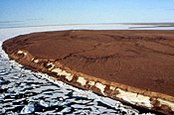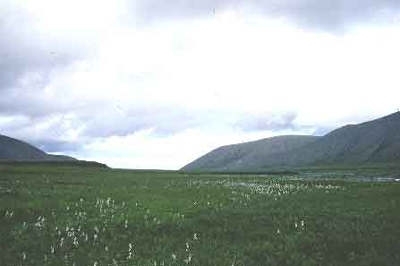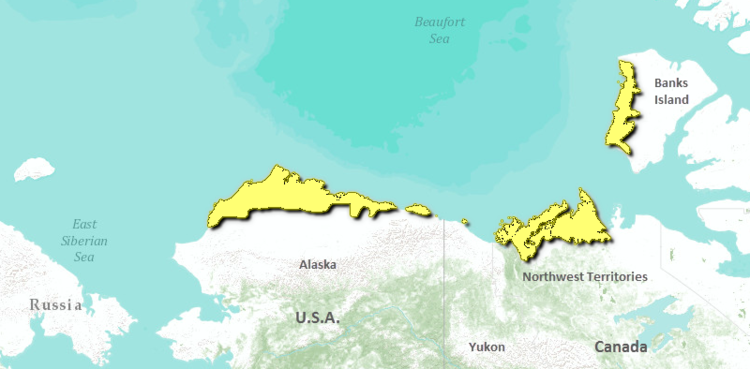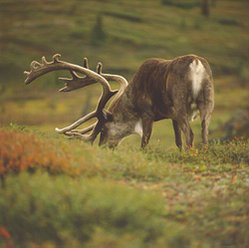Arctic coastal tundra
The Arctic Coastal tundra stretches along the northern coasts of Alaska, encompassing the eastern lowlands of Banks Island and Tuktoyaktuk coastal plains in the Yukon Territory, and the lower Anderson and Horton River plains in the Northwest Territories, covering 103,814 km2. It is a low, gradually-rising plain characterized by poor drainage, wet graminoid herbaceous vegetation communities (Carex spp., Eriophorum spp.), and many thaw lakes which cover up to 50 percent of the surface, distinguishing this ecoregion from the Low Arctic Tundra ecoregion.
The region has arctic climate conditions and is underlain by thick, continuous permafrost. The growing season extends from approximately June 15 to the end of August, although frost can occur in any month. Precipitation is relatively low, ranging from 100-300 millimeters (mm), with occasional higher values in the south, nearer to the taiga plain. Summers are very short and cool, with mean temperatures of 4.5°C on the continental coastal plain to 1°C on western Banks Island. Mean daily minimum temperature in winter is -30°C, and mean daily maximum temperature in summer is 8°C. Along with the Arctic Foothills Tundra ecoregion to the south, this region was left unglaciated in the Pleistocene, and formed part of the extensive Bering Sea Pleistocene refugium.
All of the ecoregion is low (between 0 and 150 meters above sea level [masl]) and wet (25-50 percent wetland). Also, permafrost is deep and continuous throughout the area, with very high ice content and abundant ice-wedges (pingos are also common under the continental coastal plains). On the mainland, glaciation has resulted in level to rolling fluvioglacial, colluvial and morainal deposits, in addition to marine deposits. Undulating glacial drift and outwash deposits are also common. Banks Island is unglaciated, and is characterized by low rolling hills, with western-sloping, eroded terraces. It is also worth noting that this ecoregion contains the Mackenzie River delta, and the distinctive landforms associated with it. These include active alluvial channels, estuarine deposits, and innumerable lakes.
Biological Distinctiveness
Mainland coastal plain areas support a continuous cover of shrubby tundra vegetation, consisting of dwarf birch, willow, northern Labrador tea (Dryas spp.) and sedge tussocks. Wetland vegetation is common throughout the ecoregion, including horizontal fen and low-center lowland polygon fens with small elevated peat mound bogs, or marshes along the coast. Sedges and grasses predominate in the wet soils, but in some slightly raised, better-drained areas they give way to dwarf shrub communities. The cover of mosses on the wet soils is nearly continuous, and includes Aulaomnium, Ditrichum, Calliefgon, and others. Warm sites support tall dwarf birch, willow, and alder, particularly around the Mackenzie delta and the Yukon coastal plain.
The ecoregion supports a wide variety of wildlife, including walrus (Odobenus resmarus), beluga whale (Delphinapterus leucas), polar bear (Ursus maritimus), Arctic char (Savelinus alpinus), caribou (Rangifer tarandus), red fox (Vulpes vulpes), wolf (Canis lupus), arctic hare (Lepus arcticus), Arctic ground squirrel (Spermophilus parryi), seal (Phocidae), seabirds and waterfowl. Muskox (Ovibos moschatus) are common on Banks Island.
The entire Arctic Coastal Plain is an important breeding and calving ground for many species. Three major caribou herds, the Western Arctic, Central Arctic, and porcupine herds, migrate here annually to calve, while many species of waterfowl, passerines, and shorebirds arrive in the summer to breed. The Colville Delta and Teshekpuk Lake areas are especially important for breeding birds. The coast of the Arctic National Wildlife Refuge (ANWR) in particular is extraordinarily rich and productive, especially considering its relatively constricted area. It represents the center of distribution for muskox populations in Alaska. Snow geese (Chen caerulescens) breed in small areas in this ecoregion, their only breeding sites in Alaska. Kasegaluk Lagoon, in the western section of the ecoregion, is a critical staging area for brant (Branta bernicla) and supports 2,500-3,500 beluga whales each summer. The coastal plain, especially in the Colville Delta area, is important for spectacled and king eiders (Somateria fischeri and S. spectabilis), and yellow-billed loons (Gavia adamsii) – all species of concern.
Conservation Status
Over 90 percent of the Arctic Coastal Plain habitat remains intact. The disturbance that has occurred has centered around the community of Barrow, and is associated with oil development in the Prudhoe Bay and Kuparuk oil fields. The transportation corridor that includes the Dalton Highway and the Trans-Alaska Pipeline also represents a significant area of disturbance due to direct habitat loss, potential deflection of migratory animals, and increased human access. Oilfield development is currently expanding to the west. Arco recently announced a significant discovery in the Colville Delta and interest in expansion into the National Petroleum Reserve in Alaska is at a high. The oil industry and Alaska's political leadership have a significant interest in opening the coastal plain of the Arctic National Wildlife Refuge to exploration and development. These expansions of industrial activity have potential to interrupt migration routes through an already existing natural bottleneck in the coastal plain ecoregion, and to disturb nesting habitats of waterfowl along the Arctic Coastal Plain. Other disturbances are usually local and small in scale, although recovery from vehicle or even human track disturbance is very slow, and constructs such as roads and pipelines can disrupt mammal movements and migrations.
Degree of Protection
 Meek, Banks Island, Northwest Territory, USA. (Source: Parks Canada)
Meek, Banks Island, Northwest Territory, USA. (Source: Parks Canada) - The Arctic National Wildlife Refuge represents the only large protected area in the ecoregion. The portion of the refuge that falls in this ecoregion was designated as a special study area when the refuge was created in 1980 to evaluate the potential for oil and gas development. Although the area is technically within a designated protected area, its future is not secure and may be threatened by potential expansion of oil and gas development.
- Teshekpuk Lake, important for bird migration and breeding, is a Special Management Area within the National Petroleum Reserve in Alaska.
- Ivvavik National Park - northwestern Yukon Territory (only partially in ecoregion) comprising 10,168.65 km2
Types and Severity of Threats
The main threat is the expansion of the Prudhoe Bay oil field development around the bay and into the Arctic National Wildlife Refuge coastal plain, as well as to the west into the Colville Delta and National Petroleum Reserve in Alaska. This expansion would significantly erode wilderness values and has the potential to disrupt wildlife habitat and use patterns.
Suite of Priority Activities to Enhance Biodiversity Conservation
- Ensure long-term protection for the coastal plain of the Arctic National Wildlife Refuge, to protect caribou migration and calving, bear and wolf movements and foraging, and muskox activity. These will be increasingly impacted with expansion of oil field development. Manage areas around the reserve to ensure persistence of large-scale phenomena, like migrations.
- Create protected areas in biologically important parts of the National Petroleum Reserve in Alaska, including areas adjacent to the Colville Delta, Teshekpuk Lake, and Kasegaluk Lagoon. Monitor bird populations in these areas in response to oil development activities.
- Restoration of caribou calving areas in Prudhoe Bay/Kuparuk oil fields may be necessary if current indices of decline and stress continue.
- Ensure entire coast is managed to retain its ability to support the annual concentrations of migratory waterfowl, which occur throughout the ecoregion.
Conservation Partners
- Canadian Arctic Resources Committee
- Canadian Parks and Wilderness Society, Yukon Chapter
- Ecology North
- Friends of Yukon Rivers
- Northern Alaska Environmental Center
- The Sierra Club
- The Wilderness Society
- World Wildlife Fund Canada
| Disclaimer: This article is taken wholly from, or contains information that was originally published by, the World Wildlife Fund. Topic editors and authors for the Encyclopedia of Earth may have edited its content or added new information. The use of information from the World Wildlife Fund should not be construed as support for or endorsement by that organization for any new information added by EoE personnel, or for any editing of the original content. |


